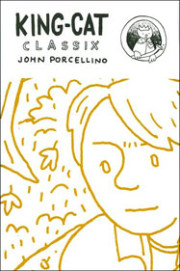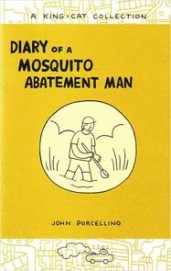Kiki Petrosino
Sarabande Books ($14.95)
by Haines Eason and Jay Thompson
Jay Thompson: While the prevailing fashions in poetry are disjunction, ambiguity, text-interpolation, formal experiments, and the interrogation of language-signs, Kiki Petrosino’s debut book is too hungry and exacting for these conversations. This is not to say her poems—about Robert Redford, goat cheese, Orientalism, quibbling lovers, ramen, secret ninjahood—are unintellectual or daydreamy. Instead, she breathes in her language’s smells and textures (raptor, cheese rind, flitch), fractures narrative in favor of sense-appetites, and ends her book wide-open to the world. She is not unintellectual: she is instead a sharp outsider, a genius of the exactingly sensual.
Haines Eason: It seems to me that to understand Fort Red Border, one first has to grapple with Robert Redford. Quite literally, in fact—the first half of the collection recounts an amorous association with the fabled actor, and yet it becomes quickly apparent that Petrosino is speaking through the situations she arranges to something larger. I have my own ideas, but what does Redford in this context represent to you?
JT: Doesn’t Redford seem like Mr. Dream America? What with his cufflinks and curious taste in food, his sexy ribs moving under his shirt and apparently bottomless well of wealth? Or is our speaker just as rich—a fellow jet-setter? Take the opening of “This Will Darken the Cabin”:
Halfway through my plate of tiger prawns
Redford returns from the cockpit tour.
Such a face, he says. Were you this soulful as a child?
He tips my chin & slides my headset back.
Redford enters these poems picture-perfectly, even when he doesn’t notice the speaker’s inner life at all. Redford loves her, it seems, and otherizes her, his African-American companion—washing her afro in a clay jar, asking what keeping it “natural” means, touching her in her sleep, asking her where she goes whenever she’s gone. But the speaker doesn’t live apart: she’s just as at home in this world of privilege as Redford is.
. . . From his leather satchel, Redford lifts
two heavy slices of baguette spread liberally
with chèvre & wrapped in wax paper. Just a second, don’t
eat that yet. He tilts the bread in my hand. Adds a crinkle
of fresh rucola. There. We watch the broken polo fields fill up
with fog.
The poems in Redford’s section are a linked set, but they don’t tell a single story. Instead, they’re traditionally organized domestic lyrics: they set a scene, then culminate in an image or epiphanic insight (“Above our heads the reading lights go out” or “Still, still, still—I am burning”). The epiphanic lyric is a lonely formal choice for a set of poems about a relationship. Without a plot thread, there’s no overarching sense of cause and effect, and we never leave our speaker’s head; her intimate negotiations with Redford never seem to alter their relationship.
Also: what is Redford doing here? Why address a celebrity as a lover—or as a foil, or as a muse?
HE: Redford is, for Petrosino’s speaker, Mr. Dream America indeed—given what we know of his looks and general aesthetic and then given what Petrosino offers of her speaker’s and Redford’s love life, we have quite the complete gentleman, a rugged rambler slash richly appointed rake. But for all the bases the debonair Redford covers, I sense—as I gather you do—that something’s amiss. A Westerner otherizing his African-American companion is where I initially landed, too.
Let’s discuss the title for a second—Fort Red Border. It’s an anagram for Robert Redford. So, by extension, Redford’s been turned into a defensive-but-aware, militaristic, colonial structure. Now this might chafe at first, but let me rattle off some films that distill what I think of when I conjure his image: Jeremiah Johnson, The Sting, Butch Cassidy and the Sundance Kid, and, for fun, let’s say The Natural.
What seems to unite these movies is the lead character’s rebellious nature—in them we meet individuals who are going to do what they want or need to do, and they are going to do it their way. In these movies we don’t see Redford in the role of colonial oppressor; rather, he’s anti-man, anti-establishment. Yet I also see him as an American Dream chaser—he’s not so much interested in knocking the guts out of the system as punching out a place in it for himself. The Natural’s Roy Hobbs plays our nation’s “classic” game with his own unschooled style, and Jeremiah Johnson is just looking for his version of 40 acres and a mule when he’s beset by “roaming” “savages” and must defend himself.
Positing this, let’s return to the anagram—specifically to “red” and “border.” The associations there for me are: red-blooded, red state, (difficulty in) crossing borders, and border protection, to start. Jay, you brought up Redford’s romancing of Petrosino’s speaker, and his many attempts to come to terms with her otherness—washing her afro in a clay jar, asking what keeping it natural means—could it be that keeping it natural for the speaker of Fort Red Border keeps this person, in the end, at a remove from Redford and all he represents (i.e., America)? I wonder this most acutely when reading lines like
So I lean back & Redford asks, “Water warm enough?”
& I don’t answer because I’m holding my breath.
I don’t know why he asks.
and
The sun is not a customizable thing.
I try to say this.
and
His shadows are grey & brown as grass.
There’s no sun here.
all from the first poem, “Wash.” Perhaps this section represents an honest attempt and failure to accept our country’s hegemonic status quo. If you can work with this, where then do the other sections—“Otolaryngology” and “Valentine”—take you?
JT: Petrosino’s poems (as passages quoted suggest) are packed with sense-life, but they never tumble or explode. The sensuality of her poetry is, instead, unfashionably slow and meticulous. Thank goodness for this restraint! Petrosino’s poems set their table before indulging: in food, skin, and even her language’s materiality. The color white is “loose as dirted screens of salt on salt.” One poem’s addressee is “the small, dark frill of lichen at the water’s brink.” Later, a river is “dead with glim.” Redford’s torso through a sleeve is a “smooth triangle,” the speaker’s face a “blooming cactus of tears.” A quick sniff of the pages also led me to double brandy, crostata, bergamot, cake frosting, green beans amandine, rigatoni all’arrabbiata. Yum!
This meticulous sense-care is foregrounded as the book goes on, and our speaker becomes less and less Redford’s Other-companion. “Otolaryngology” means ear, nose, and throat medicine. That section of the book, the second of three, is less thematic than the first (grouped around Redford), or the last (grouped around love letters), but what its poems do share is Petrosino’s tasteful interest in music and appetite—in the pleasures of hearing, smelling, tasting, reaching.
Without Redford, the speaker—a secret ninja, a child, royalty—is her own boss. “From here, I inseal you in the wild sound of cedars,” she says in “Letter”; “For always, I inseal you at the brink of my concern. Come here to me.”
We saw the speaker of “Fort Red Border” often lost in thought. Contrastingly, in “Otolaryngology,” we see into the speaker’s thoughts. One prose poem, “You Have Made a Career of Not Listening,” begins with cooking ramen. The speaker then reifies its two metaphors: the loosening noodles as both a “washed-up boxer” and as “a stranger’s face disappearing into morphine.” The poem, in this space of tangible metaphor, takes its ramen noodles someplace hard:
Some boys wipe fifty bucks’ worth of sweat from the ring, then head to the all-night diner smelling like stacks of thumbs. Meanwhile, dollar bills are blooming in the stranger’s lonely raincoat pocket. It is 5:00 a.m. There are places you will never go with me, no matter how many times you ask, or how hard you eat.
This severity feels a long way from our speaker shrugging Redford off with, “I had some soulful ways, I guess.”
So: we have poems here of taste as well as of appetite, a speaker who treats intense sensuality with intense care. In this, the poems remind me of Brigit Pegeen Kelly (who’s the source of the book’s epigraph), but Fort is less gruesome and less spiritual than Kelly’s work. It’s also less crazed about its sensual pleasure than, say, the poems of contemporaries like Chelsey Minnis or Zachary Schomburg.
Which brings us to “Valentine,” the book’s final section. These are mostly love poems, but what has changed since the book’s opening affair with Redford?
HE: Perhaps Petrosino’s speaker is less other, or she’s more other and secure in that. In saying this I’m thinking of the “Valentine” on page 77, the one in which the speaker finds herself rejected from the Bible. Here she’s addressing a nun-like person, Agnes, the one responsible for the rejection:
But riddle me this—Agnes:
Why. Does this always. Happen.
Just tell me—since you’re so smart.
OK?
You probably don’t need that Bible gig—
What with your solid gold Camaro & your hunting dogs.
But me, Agnes? I’m not like you.
I can’t afford to lick ambergris off my servants’ bellies all day.
This poem goes on to close in darkness. Insistently typing away at her computer, despite being excluded, the narrator continues her work:
Not to write poems, you understand.
Just—touching the keys.
It’s not how anyone should
get healthy, especially not me.
But there’s a darkness in that
clicking sound, a bridge so black
I can’t get over—
But I don’t read the darkness as having anything to do with despair. I read “I can’t get over,” given its privileged position in a line to itself, as both a fragment and part of the syntax leading to it. Going with the former, this means there’s something (generally) that the speaker can’t get over, the obvious conclusion being the rejection from the Bible. Now, given the sardonic tone of the earlier lines and the overall stronger tone of the speaker’s voice in this final section of the book, I am led to believe that Petrosino’s speaker is not all that wounded by the rejection (she may have been at first, in some real-time moment we’re not privy to) and is, rather, now in acceptance of her distinctness from Redford’s and the culture-at-large’s biases. Agnes’s culture is Redford’s culture—Bible, whiteness, ways of being and ways of loving that the speaker sees have no room, in the end, for her.
Taking all this, let’s return to “get healthy,” above. Given the aforementioned sardonic tone, do we now really believe this speaker wants to get healthy? The implication is that “getting healthy” is to fit in, and that fitting in would be defined on Redford’s and Agnes’s and other hegemonic players’ terms. No—this speaker is alone in the space outside the light of the Bible, but that space is only dark to those who’ve chosen to stand in the Bible’s supposed light. Who knows what room, illumination, economy exists in that supposedly outside space. I am led to believe that Petrosino’s speaker does, and she’s keeping it for herself—she can’t get over the exclusion, nor does she plan to try. She’ll continue “touching” the keys of her computer, making work that defines her, not her as Agnes would have her.
Returning to “fugue” and your question, Jay—I read the Valentines as the counter subject to “Fort Red Border” and “Otolaryngology” as the past, meaning I see the book's trajectory as this: speaker is nearly seduced by the status quo; speaker retreats to her past to regroup and find her self and passion; speaker strikes out and announces (via the motif of valentines) her position in the world.
In saying this though, I feel I need to investigate the middle a little more. Turning to “Otolaryngology”—which is indeed the study of the ear, nose, and throat—I believe we must widen our definition of that science to “the study of the head.” Recalling the first section: we had a speaker there nearly engulfed by Redford’s ruddy advances, a speaker who nearly lost her sensual self in his foreign desires. But in this middle section she shakes him, she goes home—her aim is to get her head straight, is to get down to bare dirt. I’m thinking of poems like “Gristle”:
Scratch. Chickens toss skinny
brown I hold
my plate sogged
with grease & dirty chicken
bones I ate
the yellow meat all from.
Go ahead says Uncle.
Sure don’t like to waste that sure
don’t like to waste that
sure not
me. Now my plate goes.
And poems like “The Human Tongue Slows Down to Speak”:
Mother was a sieve
Father wept.
How will I speak, when all my bones
are hewn from nets I ate
the little birds all from?
After all my rambling, though, part of me is still on the fence because my position depends on Redford occupying a supposed high ground, on him operating from the clueless position of some square majority. And as you note, as the book goes on, the sensuality does seem to heighten—Petrosino’s language becomes more lush as we read. Freed of Redford, when she’s sultry, she’s more sultry. Is this because the speaker becomes unencumbered, or is Petrosino interested in sense for the sake of sense?
JT: By the end of the book, Petrosino’s speaker is her own central agent. She’s also no longer lost in thought. The book begins with Redford, tangled in an intimate, politicized give-and-take, but it ends wide-open: “I’ll tell you what I wish.” By “Valentine” she’s building her companion:
I build you from the twelve
stoneflies I captured in a foil drinking cone.
From the Gunpowder River I build you.
From willow trees, from canoes filled with snow.
The meticulous tangibility of her poems—joining lovers, her bright tone, a world-building impulse, and her across-the-board sense of restrained pleasure—keeps their wit from seeming mechanical. Is it simplistic to say that the book is about relief in the senses?
HE: No, it’s not too simplistic—but I do think Fort Red Border has much larger aims than taking relief there. You say it yourself: world building. Petrosino’s speaker seeks to untangle sense, to make sense, to perceive and revel in sense—and seeks to do so free of the trappings of an at-large, hegemonic culture intent on bending her impulses to its will. This said, there is a backdrop. The speaker builds from Gunpowder River a lover—from willow and snow and stoneflies. This person builds a love, at the end of Fort Red Border, from the raw world persisting at the edges of our culture’s developing, pillaging impulses. This is the backdrop without which Fort Red Border cannot exist. I believe that this book seeks and finds a world before sense. The book’s final section is an imparting—from the wild to the newly cleansed voice, and from the cleansed voice to the world, awaiting.
Click here to purchase this book at your local independent bookstore

Rain Taxi Online Edition, Winter 2009/2010 | © Rain Taxi, Inc. 2009/2010
 Marcel Proust
Marcel Proust




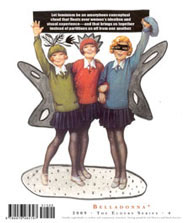
 Untitled, color photograph, 2004. Photo by Emma Bee Bernstein.
Untitled, color photograph, 2004. Photo by Emma Bee Bernstein. The Writings of Jack Smith
The Writings of Jack Smith




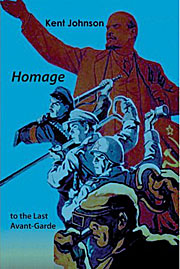
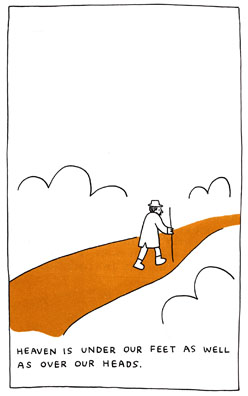 by Nate Pritts
by Nate Pritts
